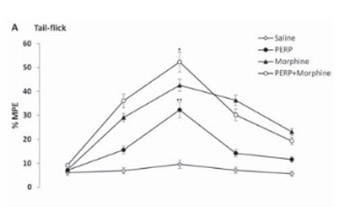Role of D1/D2 dopamin receptors antagonist perphenazine in morphine analgesia and tolerance in rats
DOI:
https://doi.org/10.17305/bjbms.2013.2394Keywords:
dopamine receptors, perphenazine, analgesia, morphine toleranceAbstract
While opioid receptors have been implicated in the development of tolerance, the subsequent mechanisms involved in these phenomena have not been completely understood. The purpose of this study was to investigate effects of D1/D2 dopamine receptors antagonist perphenazine on morphine analgesia and tolerance in rats.
Male Wistar albino rats weighing 190–205 g were used in these experiments. To constitute of morphine tolerance, animals received morphine (50 mg/kg) once daily for 3 days. After last dose of morphine was injected on day 4, morphine tolerance was evaluated by the analgesia tests. The analgesic effects of perphenazine (1, 5, and 10 mg/kg), D1-dopamine receptor antagonist SCH 23390 (1 mg/kg), D2-dopamine receptor antagonist eticlopride (1 mg/kg), and morphine were considered at 30-min intervals (0, 30, 60, 90, and 120 min) by tail-flick and hot-plate analgesia tests.
Obtained data suggested that D1/D2 dopamine receptors antagonist perphenazine was capable of suppressing opioid tolerance, possibly by the mechanism of inhibiting D2-dopamine receptor. Because the data indicated that D2-dopamine receptor antagonist eticloride, but not D1-dopamine receptor antagonist SCH 23390, significantly decreased morphine tolerance in analgesia tests. In addition, administration of perphenazine with morphine increased morphine analgesia.
Results from the present study suggested that dopamine receptors play a significant role in the morphine analgesic tolerance. In particular, D2-dopamine receptor has an important role rather than D1-dopamine receptor in development tolerance to morphine.
Citations
Downloads

Downloads
Additional Files
Published
How to Cite
Accepted 2017-08-30
Published 2013-05-20









